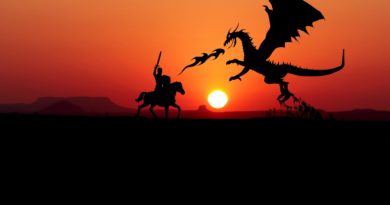Nimrod: Archetype of the Antichrist
By S. Douglas Woodward
One of the most intriguing characters in the Old Testament is Nimrod, son of Cush, and grandson of Ham.
His name often comes up as the archetype of the Antichrist. It turns out that when we dig into the story surrounding Nimrod, there is much more to be said about his importance than just the speculation that he might be figure who arises again in the last days (“who was, is not, but will be again” – Revelation 17:8) as the Antichrist.
Most of you who read this follow me regularly. You are aware that I am working on part two of Rebooting the Bible. Many have asked me when I will get this done. It is difficult to say because as I dig into the questions like who is Nimrod, according to archeology, it is a most complex question.
Likewise, understanding the meaning of the Tower of Babel escapes an easy answer. Much of what we are typically taught about Nimrod and the Tower of Babel is probably wrong. My research indicates that there is a depth to these issues that unlocks the key to the meaning of the primeval history of the Bible as disclosed to us through the first eleven chapters of Genesis – from Adam to Abraham.
My primary thesis is that “literalist” biblical history is shackled to the “fake history” developed from the corrupted Hebrew Bible. The rabbis altered the genealogy and thus the chronology revealed to us in Genesis 5 and 11. The standard view which is associated with the King James Bible (whose Old Testament was translated for the most part from the corrupted Hebrew Bible) has pulled those who investigate biblical chronology and its many associated themes, such as Young Earth Science and biblical archaeology, down a well-trod but misguided path.
Primeval history according to the Hebrew Bible has the Creation at 4004 B.C., the Flood at 2348 B.C., and the Tower of Babel event approximately 100-150 years later – roughly 2200 B.C. Given these historical “markers,” it is no surprise that those who attempt to map what we know from archaeology in Egypt and Mesopotamia have a nearly impossible task and simply cannot reconcile the Bible’s history with what the science of archaeology teaches to be true.
Archeological Science Isn’t ‘Bad Science’ Like Evolution

We must understand that archaeology is an empirical science.
It is not like evolution as an explanation for the origin of life, for evolution is a theory only. Evolution is not an empirical science – while archaeology is. Although archaeology can be influenced by premises that may be very unbiblical, generally it is fact-based.
Artifacts pulled out of the ground, supply the grounds for its claims. And when it comes to Egyptology and Mesopotamian Archaeology, there is an enormous volume of significant written records telling the story of Sumer and Egypt.
In Mesopotamia, Cuneiform tablets preserve its history from these primeval times that takes us back to roughly 2800 B.C. and earlier. Most scholars believe that the first light of civilization in a conventional sense originates in Sumer about 3,100 B.C. (in the Jemdet Nasr period).
The location and first dynasty were known as Kish (Cush). Kish was the first city. As the reader may recall. Cush was the son of Ham. In Egypt, monuments and “wall inscriptions” (hieroglyphic graffiti as it were), tell its story and Egypt too has its genesis in this same era.

The academic view generally follows the biblical view: The Bible indicates that Egypt begins with Mizraim (which means Egypt). Mizraim was the son of Ham, just as was Cush, Put, and Canaan. Egypt’s first dynasty began about 3100 B.C. The first pharaoh is Narmer (also Menes).
In fact, we also know that the history of China begins with the Sinites (from Sino or China) who were descendants from Cush. The ancient history of China is often identified going back well beyond the dates of Adam – as some other cultures do. (which leads to speculation that there was a “Pre-Adamic Race” before the Garden of Eden and the special creation of Adam and Eve. But we have a definite time market: There are bronze artifacts in China dating to 3100 B.C.
The Kingdom of Nimrod, circa 3000 B.C.

Likewise, as I said the writings of ancient historians and the hieroglyphs etched into stone in many Egypt monuments elaborate in detail and supply the history that other cultures in ancient times affirmed, primarily the Greek culture through its historians such Herodotus (484 B.C.-425 B.C.), the father of history, who recorded the history of the ancient world in the fifth century B.C.
The first dynasty of Egypt supposedly began circa 3100 B.C. As I pointed out in Rebooting the Bible Part One, that history is inflated by about 300 to 350 years. The more likely date for Egyptian beginnings is tied to the heliacal rising of Sirius in the constellation Leo, about 2770 B.C. (This is the so-called Sothic Cycle.) And when we examine the Sumerian King Lists, such as presented by Egyptologist and historian David Rohl, we see the lineage of Kish (aka Cush), beginning about the same timeframe, circa 2800 B.C.
What does this imply? It means that the conventional notion that the Tower of Babel took place around 2200 B.C. is refuted by archaeology from empirical evidence from Egypt, China, and Sumer. The Akkadian civilization which was a Semitic culture (from the line of Shem and northern Canaan) followed Sumer, most notably beginning with Sargon I (Sargon the Great) whose birth and death are firmly established (2360 B.C. to 2279 B.C.).
Scholars indicate that Sargon was a Semite and was the first empire builder in the ancient world. For this reason, some scholars like Douglas N. Petrovich (whose work I great appreciate), argue forcefully that Sargon I was Nimrod.

Indeed, his supposition that leads him to think this is that the biblical record demands Nimrod lived roughly 100 to 150 years after a great flood as recorded in the Hebrew Bible. And, according to Ussher and the King James Bible, the Flood of Noah took place in 2348 B.C. Nimrod would appear in history, circa 2200 B.C. This timing doesn’t quite fit the biblical timeline from the Hebrew Bible; however, it’s close.
But, wait a minute. The big question that must be answered first is, “Does the Bible really testify to the Flood in 2348 B.C. and the Tower of Babel roughly 2200 B.C.?”
As I argued in Rebooting the Bible (RTB), Part One, it doesn’t require this if we follow the authentic version of the Hebrew Bible. Ezra assembled the earliest version of the Hebrew Bible circa 440 B.C. and it was this Bible that was translated into Greek in Alexandria, Egypt, circa 282 B.C. The Greek Bible presents us with a snapshot of what the authentic Hebrew said. Today’s Hebrew Bible wasn’t cast until about 400 years after the Septuagint (282 B.C. for the Greek Bible and circa A.D. 120 for the “Akiba Bible” (Rabbi Akiba being the leading Rabbi who drove the process). This later Bible had a chronology altered by Akiba and the rabbis. It is this Greek translation of the original Hebrew Bible of Ezra that establishes a chronology about 1,500 years longer, taking us back to Adam’s creation, roughly 5500 B.C. (my calculations set the date at 5616 B.C.)
Consequently, I argue the Flood of Noah transpired circa 3359 B.C. (1,000 years earlier than the Akiba/Ussher/KJV chronology), and the Tower of Babel event, likely about 3150 B.C., or 200 years after the Great Flood.
The first traces of the post-diluvian world pop up right around 3100 B.C. As I point out, once we understand this and we rightly establish the timing of the Egyptian dynastic period beginning circa 2800 B.C., Sumer’s King List, the earliest historical “Sino” dynasty in China also in the same timeframe, we have pinpointed the timing of “the Tower of Babel event,” i.e., within 100-200 years of the Great Flood.
Additionally, we then have an adequate number of years for the division of tongues leading to the dispersion of nations – about 300-350 years – from Babel to the beginning of these mighty ancient civilizations.
While Petrovich argues for Sargon as the mighty Hunter before (who “opposed”) the Lord (i.e., Nimrod circa 2200 B.C.), all the other cultures’ genesis provides empirical proof (on a global basis) that Sargon couldn’t have been Nimrod and “the Dispersion of the Nations” happened about 1,000 years earlier.
Gilgamesh – The Mythical Figure Pointing to Nimrod?

Case in point: Consider the Epic of Gilgamesh.
The Legend of Gilgamesh strongly hints that Gilgamesh would be a better candidate for Nimrod. And here’s why: Gilgamesh was known as the mighty hunter in Sumer and later by the Akkadians.
Gilgamesh was motivated by preserving his kingdom from destruction by yet another great flood. And he was considered a demigod. Gilgamesh, according to his legend, went and battled Huwawa (Note: a closely matching pronunciation of YHWH – as in “who wah wah”).
This took place in northern Canaan (one possible location for his relatives, possibly even a grandfather, Ham). Legend has it that his real father was Dumuzid (i.e., Tammuz, the God of the Underworld, i.e., the Hebrew Satan, see Ezekiel 8:14). His wife was identified as Inanna who became Ishtar (Astarte, Semiramis) and some legends tell us that he lost an eye somewhere during his exploits.
Thus, the hero of the ancient world had only one eye – methinks of the singular “all-seeing eye” – the great symbol of Osiris/Horus/Lucifer. This might be the origin of this cultic symbol. Other associated aspects of the legend indicate that his name was Asar (Assur) who also became Osiris of the Egyptians (Asar/Assur/Osiris).
And Gilgamesh was a giant, one of the suppositions of popular author Tom Horn and many other Evangelicals who study this topic (e.g., Gary Stearman, L.A. Marzulli, Brian Godawa). “And Cush begot Nimrod; he began to be a mighty one in the earth. “(Genesis 10:8)

Curiously, his friend Enkidu, is a hybrid which also alludes to another (possibly) legendary assertion that the Nephilim not only were a race of hybrid humans (a cross of angels and humanity), but the Sons of God angered God by creating hybrids or chimeras in the days of Noah (and afterward?)
The non-canonical book of Jasher states, “And their judges and rulers [the Watchers] went to the daughters of men and took their wives by force from their husbands according to their choice, and the sons of men in those days took from the cattle of the earth, the beasts of the field and the fowls of the air, and taught the mixture of animals of one species with the other in order therewith to provoke the Lord; and God saw the whole earth and it was corrupt, for all flesh had corrupted its ways upon earth, all men and all animals.” (Jasher 4:18)
David Rohl argues that Gilgamesh was possibly inspired by the historical Nimrod, but he places Gilgamesh in the Sumerian King List roughly 400 years before Sargon (circa 2700 B.C.) and identifies several other kings prior to Gilgamesh (which wouldn’t be consistent with the biblical testimony). Crucially, however, Rohl supports the view that the Kish Dynasty references the Cush of the Bible.
The Giant Demigod, Gilgamesh, and His Hybrid Friend, Enkidu

Another important point is whether Nimrod was the leader of the Tower of Babel rebellion.
Nimrod’s name means rebel (or “to rebel”) and Babylon was a rebellion and an attempt by the descendants of Noah to “make a name for themselves” (something Gilgamesh was concerned with as well).
But recall that the biblical text does not precisely indicate that Nimrod led the rebellion at the tower of rebellion. He is the usual suspect, thanks mostly to the words of Josephus. But it is Nimrod who is renowned for the creation of historic cities – four famous ones in Sumer and then afterward northward in Assyria (named from Asar or Asshur).
Nimrod appears to be the founder of cities to control the action of his subjects. But this doesn’t automatically mean he was the figure that forged the idea to bake bricks and build a great tower to anchor all of humanity (or even just the Hamites, if that is what the text means).
And recall that Asshur is the name associated with Nimrod and the Antichrist, i.e., “the Assyrian” in many OT prophecies. Isaiah 14:25, “I will crush the Assyrian in my land; on my mountains I will trample him down…” Isaiah 30:31: “For the voice of the Lord shall the Assyrian be beaten down, as he strikes with the rod.” And Micah 5:5, “When the Assyrian comes into our land and treads in our palaces, then we will raise against him seven shepherds and eight princes of men…” Some equate Assur with Nimrod, others with his son. Assur, like Kish (Cush), is both a place and a person. This nomenclature is preserved today as we still talk of Assyria and Syria.
Conclusion – Timing of the Exodus the Key to Bridge to Biblical Primeval History

In short, once we consider the fact that ancient sources corroborate the chronology of the Greek OT, i.e., the Septuagint), suddenly Mesopotamian archaeology and Egyptology coincide closely with the Bible’s primeval history.
I have already shown this in part regarding Egypt’s first dynasty in Rebooting the Bible Part One. However, the goal in part two of Rebooting the Bible will be to offer much more proof that the Septuagint chronology allows us to understand not just when these most intriguing events took place, but when assigned their correct date, what this context tells us about the Bible’s message that transcends what we’ve been taught to date.
In fact, I have laid out this historic chronology embraced by Christendom in a number of articles on my web site and in my two most recent books, Rebooting the Bible Part One, and A Biography of the Christian Bible. Part Two of RTB will look at all the seldom understood aspects of the colossal events of Genesis 1-11 and retell the stories in the context of when they transpired – according to the historic chronology as set forth in the Septuagint.
As far as Rebooting the Bible, Part One is concerned, the reader will find it essential reading. You will want to work through the information establishing the timing of the Exodus, when the conquest of Canaan transpired, the time of the Judges, and the Israelite kings.
Once we have corrected the timing up to and including Abraham, then we are able to jump from Abraham (whose story commences in Genesis 12), back to Peleg, the division of the nations, Nimrod, the Tower of Babel, the Flood, the antediluvian period, the Garden of Eden, and beyond to what archeological findings seem to indicate – that before Adam and Eve there was another humanity and another world (2 Peter 3:5-6). Therefore, if you haven’t already, I urge you to purchase and read Rebooting the Bible, Part One.


S. Douglas Woodward, Th.M., MA in Finance, is 64. He grew up in Oklahoma City, where he lives once again, after working in Boston for six years and Seattle for 21 years. Doug’s experience lies primarily in business information technology and financial management where he has served as an executive for Oracle, Microsoft, and a Partner at Ernst & Young LLP. He also founded his own consultancy for young companies, Smart Starters, which he managed for 10 years, before becoming Entrepreneur-in-Residence at the University of Oklahoma, Price School of Business, where he has taught classes in entrepreneurship for five years. Over the past seven years, Doug has become a nationally recognized author having written many books on the topics of America’s spiritual history, eschatology, theology, and geopolitics. His books of note include The Final Babylon, Decoding Doomsday, Power Quest (Books One and Two), Lying Wonders of the Red Planet, The Revealing, The Next Great War in the Middle East, Revising Reality, Rebooting the Bible and A Biography of the Christian Bible. He frequently appears on radio and television programs having been interviewed on over 100 different occasions on several dozen different shows. Additionally, he speaks at conferences concerning the multiplicity of topics about which he writes. Doug has two amazing adult children, an incredible daughter-in-law, two fabulous grandsons, and a beautiful wife, Donna, with whom he celebrates over 43 years of marriage. Discover more at www.Facebook.com/sdouglaswoodward and www.faith-happens.com.



